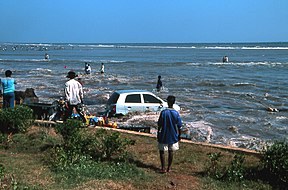
A natural disaster is the very harmful impact on a society or community after a natural hazard event. Examples of natural hazard events are avalanches, blizzards, droughts, dust storms, earthquakes, floods, hails, heat waves, impact events, landslides, sinkholes, tornadoes, tropical cyclones, tsunamis, volcanic activity and wildfires. A natural disaster can cause loss of life or damage property. It typically causes economic damage. How bad the damage is depends on how well people are prepared for disasters and how strong the buildings, roads, and other structures are. Scholars have been saying that the term natural disaster is unsuitable and should be abandoned. Instead, the simpler term disaster could be used. At the same time the type of hazard would be specificed. A disaster happens when a natural or human-made hazard impacts a vulnerable community. It results from the combination of the hazard and the exposure of a vulnerable society.
Nowadays it is hard to distinguish between natural and human-made disasters. The term natural disaster was already challenged in 1976. Human choices in architecture, fire risk, and resource management can cause or worsen natural disasters. Climate change also affects how often disasters due to extreme weather hazards happen. These "climate hazards" are floods, heat waves, wildfires, tropical cyclones, and the like.
Some things can make natural disasters worse. Examples are inadequate building norms, marginalization of people and poor choices on land use planning. Many developing countries do not have proper disaster risk reduction systems. This makes them more vulnerable to natural disasters than high income countries. An adverse event only becomes a disaster if it occurs in an area with a vulnerable population.
Types[edit | edit source]
Earthquake proofing for buildings[edit | edit source]

Earthquake-proofing for buildings is an essential issue in geologically unstable areas. In order to assess on whether a region lies in an area where substantial earthquakes occur, we first take a look at the earthquake hazard map. Another thing to realize is that, despite the name, the building can (almost) never be made completely earthquake-proof, in most cases, the house will still suffer damage or may still be destroyed, but the "earthquake-proofing" will prevent or reduce the loss of human lives in the process.





